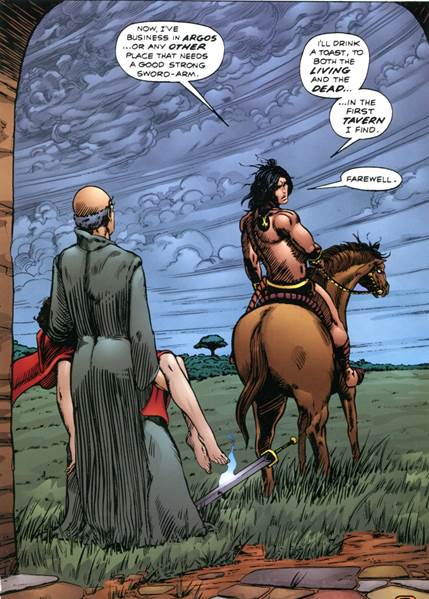
(Hyborian Bridge 21)
Zukala (originally from Conan #5) is the sorcerer who is also an intermediary between Man and the demonic forces, losing his daughter in the process and gaining humility. Man is part of nature and nature is ethereal in its dark entanglements.
In this glass world (of reflections ROADSINGER) the acolytes of sorcerers engineer a universe of perspective POV; that is, a universe of the head not the body. In Pictorial 43 (“speed”) this universe of the head always heads towards the vanishing point (Cosmic Curmudgeon 1,2)
What I mean is, all the acolytes. If it’s Darwin, then you have Richard Dawkins and David Atten-bore. If it’s Marx, then you have the Marx Brothers and Christy. If it’s Adam Smith (Hyborian Bridge 6) you have the entire monetary system. Einstein, see passim. Acolytes are people who talk and don’t act; it never occurs to them that we are in a world of primal action – running, the chase.
EVERYTIME I DREAM
In the dream is the chase, but in our outer reality is a type of nothingness. Where the sorcerers simply have a theory, the acolytes make it a reality, a reality of the head or perspective POV. Everytime they speak they are heading into the vanishing point, basically because modern science makes it possible to enable the reality.
Whereas a theory takes place in the primal world of night and day, the reality of the acolytes is pure light and heat. The reality is therefore artificial, in much the same way as Relativity applies to the sun but not the ethereal moon (physical substance, the chase, blood, the tang of game hanging to dry/age)

Hyboria is a dream and therefore is not subject to the whims of an acolyte vision (such trivia as perspective) that make of our gay world a routine of thought-processes. The reason is that the thought-processes of acolytes cannot take-in that dark and light are intermingled in the rotation of Earth’s axis.
To them, everything is light; there is no action, no chase through shadowy wood, just the routine of pure thought. The end-product of this process has to be AI, the apotheosis of routine. This was brought home to me by a piece in DT on how bees have been found to be capable of simple addition and subtraction (+1, -1). Dumbfounded boffins have hailed this as giving some design pointers to AI, since an abstract concept like addition clearly doesn’t require much neural complexity in bees.
What seems to have escaped the boffins is that bees are bound to be much closer to machines than Man since their lives are almost pure routine! They are supremely adapted to being thoroughly stupid. I’m not casting aspersions; they are the best at what they do, but they’re no Einsteins.
In natural living – including bees, natch – there are always two things going on. One is routine, and the other is the dream of the universe. The dark night dwindling to daylight; the athletic proportions of animals; the poise and grace of a simple snake. The primal substance of life without which all is as nothing.
We who are subjected to the perspective POV of acolytes would do well to look back to the early Renaissance and Mantegna – Hyborian Bridge 49. As noted there, BWS’s style developed a similar frieze-like clarity, where near and distant are equally defined.
In the final page from #15 above one can imagine birds nesting on distant branches; the movement of clouds; intermingled grass and stone. There is a wide vista of psychic strength whereby, like Mantegna, there are two things going on which are almost opposites. One is the technical foreshortening and perspective views; the other is the attention to detail that defies distance, a pre-Raphaelite hallmark.
Do you see where this is heading? In a world dominated by perspective, the telling detail is lost to distance. It is psychologically weak because the details that are accentuated are purely factual; relating to distance travelled.
In a psychologically strong world like the early Renaissance, details are accentuated for their psychological depth, not their factual depth. BWS is quite good at doing this (so is Frank Thorne, natch) using the flourishes of art-nouveau.
In a universe of perspective POV, facts relate to POV and not to physical substance since, if you think about it, physical substance and psychology have to go together (the venison hanging; the psychology of the hunter, blood and spirit).
The physical substance of BWS’s picture above is everything in the composition equally, from foreground paving to far off tree to high up clouds and birds unseen. A composition is not perspective, it’s physical substance. This applies to quite a lot of classic comic art, as CC Beck said, he threw down vanishing points wherever he could get away with it, ie to advance the storytelling.
What you realize is a technical world of POV is totally reliant on vanishing point – see “speed” – there is no physical substance (proportion) and it is psychically weak. To see why this should be so, imagine a traditional American Indian village of tepees. The reality is the commune, its lineage, and these are symbolised by totem poles and ancestors. You could take a photo of it or do aerial surveying (for real estate, natch) but that doesn’t change the fact of what it is (see empirical tradition Hyborian Bridge 25)
When “they” speak of facts they don’t mean physical substance or psychic vistas (or dreams). They mean the POV of technique that always points towards the vanishing point; a type of nothingness where fact becomes fiction (disproportionate). They mean the head, not the proportionate body.
You know when Kellyanne Conway said there are “alternative facts”? In a world of POV that’s got to be true, though I guess she wasn’t referring to a native Indian village! (that might be Sarah Palin?) Physical substance is symbolised by the ethereal moon; something mythical, not something to be measured with a ruler or surveyor’s graticule.
I was watching Discovery’s History of Rome in a triple CD set, and it gets some things very right. For instance, Rome was not planned like other Roman cities since it grew in tangled alleyways weaving round monuments of state, the sweat and dirt and squalor of the people (plebs) not to mention the odd crucifixion. Rome’s legacy to us was SPQR, or the Senate and People of Rome. The monuments remain, but the freedom and behaviour of the people made Rome Rome (see Hyborian Bridge 19)
In other ways, I don’t think they give sufficient credence to the pagan strength of belief. For all Rome’s construction and planning, they were only means to an end, and the end was honor and primitive transcendence of the city itself, established through Vestals and the eternal flame (Tros, Hyborian Bridge 18)
That’s the difference between modernity and the ancient world – including Hyboria. To us (meaning “them”) construction and planning are the ends. To the ancients, psychic strength, belief in gods and thereby physical substance are the ends.
If you’ve been following what I’ve been saying on city-states, alongside the monuments are beliefs and free-expression of higgledy-piggledy populace. The end-product of construction and planning per se is a type of nothingness, psychic deadness and disproportionate reality (now – but see next page!)
Now, this is where Howard’s fantasy comes into its own, since he is not only fixated on muscular bodies allied to keen intellect, but all his fiction – including the historical adventures – takes place outside “the dominion of fact”. In a way his mindset is much more medieval, whereby a city-state – as Vienna in The Shadow of the Vulture or Jerusalem in The Sowers of the Thunder – becomes the single point of all existence, as if they are in truth myths, and not just points on the compass.
Home







